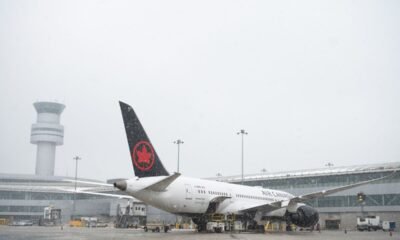Flight Buzz
Over 750 flights canceled: Southwest passengers left stranded across the US
Southwest Airlines has spent the better part of the past week trying to dig itself out of a full-blown travel mess, canceling more than 750 flights and disrupting thousands of passengers from Dallas to Los Angeles. The wave of cancellations affected some of the carrier’s busiest hubs – Dallas Love Field, Denver International, Chicago Midway, Phoenix Sky Harbor, Las Vegas, Orlando, and Los Angeles International, according to Alabama Media Group. Even international routes were caught in the fallout, with flights to and from several foreign destinations also being scrapped.
Also read: United Airlines shares positive update for mid-air travelers amid massive system outage, ground stop
While the airline has yet to give a single, clear explanation for the mass cancellations, aviation experts say problems of this scale almost never boil down to just one cause. Alabama Media Group cites travel outlet Travel and Tour World, which pinned a big share of the blame on rough weather. Thunderstorms rolled through key regions in the Midwest and along the West Coast, tangling up heavily trafficked airspace above hubs like Chicago and Phoenix. Those delays set off a chain reaction, rippling through the airline’s schedule.
One snag turns into a nationwide mess
According to travel analyst Paramita Sarkar, air traffic control systems are still stretched thin from the surge in summer travel, struggling to keep pace with packed flight schedules and congested skies. That alone is enough to cause delays. But Southwest’s point-to-point route model – which strings flights together instead of funneling through a central hub – makes it especially vulnerable when things go wrong.
“This kind of setup can snowball quickly,” Sarkar told Travel and Tour World.
A delay in Phoenix could mean a plane never reaches Las Vegas in time, which then prevents it from making its Orlando flight, and so on. By the end of the day, a hiccup in one corner of the country can strand passengers thousands of miles away.
Also read: Frontier Airlines warns of major US flight cuts: Here’s how travelers could be impacted
What Southwest is offering
Southwest says it is working to take care of stranded travelers by booking hotel rooms for those facing overnight waits, issuing refunds, and handing out travel vouchers to passengers who opt not to rebook. Even so, Alabama Media Group reports that hundreds are still stuck in airports, some camping out overnight in gate areas, waiting for updates that seem to shift every hour.
FAQs
Why did Southwest cancel over 750 flights?
Weather, staffing shortages, and operational issues all played a role.
Which airports were most affected?
Dallas Love Field, Denver, Chicago Midway, Phoenix, Las Vegas, Orlando, and LAX saw major impacts.
Are international flights affected?
Yes, some international routes were also disrupted.
Is Southwest offering compensation?
The airline is providing refunds, vouchers, and hotel accommodations in some cases.
How long will the disruptions last?
The airline has not given a clear timeline for full recovery.
Flight Buzz
Air India suspends Delhi Washington flights from September 1. Here’s why

Air India has announced the suspension of its direct flights between Delhi and Washington, D.C., effective from September 1, 2025. This decision is part of a strategic move to maintain the reliability of its route network, amid operational challenges related to fleet availability and geopolitical factors.
Affected passengers will be contacted to discuss alternative travel arrangements, including rebookings or full refunds, in accordance with their preferences.
The primary reason for the suspension is the ongoing retrofit programme of Air India’s Boeing 787-8 aircraft, which began last month. The extensive upgrades aim to enhance customer experience but will lead to the temporary unavailability of multiple aircraft until the end of 2026. This situation is exacerbated by the continued closure of Pakistani airspace, which has added complexity to Air India’s long-haul operations.
Despite the suspension of the Delhi-Washington route, Air India will continue to offer one-stop services to Washington, D.C., through its partnerships with Alaska Airlines, United Airlines, and Delta Air Lines.
These collaborations allow passengers to travel seamlessly via four US gateways: New York (JFK), Newark (EWR), Chicago, and San Francisco. Customers will benefit from a single itinerary and checked-through baggage to their final destination.
Furthermore, Air India remains committed to its North American operations, maintaining non-stop flights from India to six major destinations, including Toronto and Vancouver in Canada. This ensures continued connectivity and options for passengers traveling between these regions.
The suspension is a calculated decision by Air India amidst a broader context of fleet management and operational integrity. The Boeing 787-8 retrofitting project is a critical component of Air India’s strategy to boost customer satisfaction and enhance flight services.
The airline acknowledges the inconvenience this decision may pose but emphasises its long-term vision to improve service quality. By investing in fleet upgrades, Air India aims to position itself more competitively in the international aviation market.
Air India assures that the temporary suspension will not affect its commitment to providing robust air travel services. The airline is working to minimise disruptions and ensure that passengers have access to alternative travel options.
The airline’s proactive communication with affected passengers and its strategic partnerships with other carriers underscore its efforts to maintain a high standard of service and customer care, despite the operational challenges faced.
Flight Buzz
Izmir And Istanbul Airports Stand Strong After Massive 6.1 Magnitude Earthquake How Is Travel Impacted Are Flights Cancelled Or Severely Delayed Amid Crisis In Western Turkey

Published on
August 11, 2025 |
A powerful 6.1 magnitude earthquake struck near Izmir, Turkey, raising immediate concerns about travel disruptions in the region. However, thanks to swift emergency response and robust infrastructure, key airports including Izmir and Istanbul remain fully operational, ensuring that flights continue with minimal interruption. This resilience highlights Turkey’s preparedness and quick action in safeguarding critical travel hubs despite the natural disaster.
A powerful earthquake measuring 6.1 on the Richter scale struck near the city of Izmir in western Turkey, sending shockwaves of concern throughout the region, especially regarding travel disruptions. The seismic event occurred late on Sunday evening, August 10, 2025, originating in Balikesir province—a region situated relatively close to Istanbul, Turkey’s largest and busiest metropolitan area. This quake has reignited attention on Turkey’s vulnerability to seismic activity and the resilience of its critical infrastructure, particularly its airports and transport systems.
In response to the earthquake, Turkey’s disaster management agency quickly mobilized a significant emergency response. Over 300 rescue personnel were dispatched to the affected areas, supported by nearly 80 specialized vehicles, to conduct search and rescue operations, assess damage, and provide immediate relief to impacted communities. The quake’s strength has sadly resulted in at least two confirmed fatalities so far, underscoring the human toll that natural disasters can inflict despite modern preparedness measures.
Despite the considerable magnitude and the initial fears of widespread damage, early reports indicate that regional travel infrastructure has largely withstood the tremor. Izmir Airport, which serves as a major gateway for tourists and business travelers to the western coast of Turkey, remains fully operational as of the morning following the quake on August 11. Flights continue to arrive and depart on schedule, reflecting the airport’s structural resilience and swift safety checks post-earthquake. Similarly, Istanbul Airport, one of the busiest hubs in Europe and a key international transit point, has confirmed uninterrupted operations, providing reassurance to both domestic and international travelers.
While the primary airports have maintained normal functionality, travelers are strongly advised to remain vigilant. The nature of seismic activity means aftershocks are expected and can occasionally disrupt transport services. To date, at least 20 aftershocks ranging between magnitude 3.0 and 5.0 have been recorded, causing minor tremors felt in surrounding areas. These aftershocks could potentially lead to brief delays, schedule adjustments, or precautionary inspections, which makes it prudent for passengers to verify their flight statuses through official airline notifications or airport communication channels prior to departure.
The rapid and coordinated response from Turkey’s emergency teams has played a crucial role in preventing the situation from escalating into chaos. By quickly deploying rescue forces and initiating damage assessments, authorities have managed to secure critical infrastructure and maintain operational stability in transportation hubs. Airports in Izmir and Istanbul, vital for both internal mobility and international connectivity, continue to function as reliable access points, helping sustain economic activity and travel flow during a difficult time.
Local governments and disaster management officials remain on high alert, continuously monitoring the evolving situation. While no major damage to airport facilities has been reported, assessments are ongoing to detect any hidden structural issues that could impact safety. On the ground, transportation networks and public services might experience intermittent interruptions due to road conditions or emergency activities, so travelers using local transit options should stay informed via local news and official advisories.
This earthquake serves as a stark reminder of Turkey’s geographical susceptibility to earthquakes due to its location on active fault lines, notably the North Anatolian Fault and the East Anatolian Fault. Consequently, emergency preparedness remains a top priority for the nation’s authorities. Continuous investments in seismic monitoring, infrastructure reinforcement, and public awareness campaigns aim to mitigate the effects of future quakes and protect citizens and visitors alike.
For those planning to travel to or through the western region of Turkey, flexibility and vigilance are essential. Keeping updated with real-time information from airlines, airports, and local authorities will help navigate any sudden changes to travel plans. Despite the tremor’s strength, the continued functionality of the major airports signals that key travel corridors remain intact, allowing most travelers to proceed with their journeys.
Although the 6.1-magnitude earthquake near Izmir has caused tragic loss of life and necessitated urgent emergency responses, the major air travel hubs of Izmir and Istanbul have so far operated without significant disruption. Passengers are encouraged to confirm their flight details and stay alert to further updates, but overall, major travel interruptions have been avoided. The situation is still evolving as aftershocks continue, yet Turkey’s strong infrastructure and prompt emergency response have ensured stability in the critical hours following the quake.
Flight Buzz
India And Philippines Unlock New Horizons For Travelers By Agreeing On Mutual Visa-Free Policies And Launching Five Weekly Direct Flights Using Modern Aircraft

Published on
August 11, 2025 |
India and the Philippines have taken a significant leap toward enhancing travel and tourism by agreeing on mutual visa-free policies and launching five weekly direct flights operated with modern aircraft. This groundbreaking move removes traditional barriers to travel, making it easier for citizens of both countries to explore new destinations, strengthen business ties, and deepen cultural connections. By simplifying entry requirements and improving air connectivity, both nations aim to boost tourism, foster economic growth, and create stronger people-to-people links that pave the way for expanded cooperation and shared prosperity.
The Philippines and India have recently agreed to a groundbreaking visa-free travel arrangement that promises to deepen the ties between the two countries and boost tourism significantly. This decision, announced during a high-level state visit, marks a pivotal moment in bilateral relations, signaling a fresh wave of cooperation aimed at facilitating travel, cultural exchange, and economic growth.
Starting in October 2025, travelers from both countries will enjoy visa-free entry for up to 14 days upon arrival, making short visits easier and more accessible than ever before. This new policy eliminates previous visa requirements, streamlining the process for tourists, businesspeople, and students alike. By removing barriers, the two nations aim to foster a stronger connection among their citizens and encourage more frequent visits.
Alongside the visa waiver, direct air travel between the Philippines and India will resume with a new nonstop flight route launching on October 1, 2025. This service will operate five times a week, connecting the capitals with modern Airbus A321neo aircraft. This new route will make the airline the only carrier offering direct flights between the two countries, drastically reducing travel time and improving convenience for passengers.
The strategic partnership behind these developments represents more than just travel convenience—it reflects a shared vision to strengthen people-to-people ties and promote mutual understanding. The new visa-free scheme and direct flights are expected to open fresh opportunities for tourism, business ventures, academic exchanges, and cultural collaboration.
The reciprocal visa-free policy offers several benefits for travelers from both countries. Tourists can now plan spontaneous trips without worrying about lengthy visa application processes, which often act as deterrents. Business travelers will find it easier to attend meetings, conferences, and trade shows, expanding commercial relations and investment opportunities. Students and academics can pursue short-term educational programs or collaborative research projects with fewer administrative obstacles.
Tourism experts anticipate a surge in visitor numbers as the two countries capitalize on each other’s unique attractions. The Philippines, renowned for its stunning beaches, vibrant festivals, and rich biodiversity, is poised to attract more Indian tourists seeking adventure and cultural immersion. Meanwhile, Indian heritage sites, spiritual retreats, and diverse cuisine present exciting new destinations for Filipino travelers.
Direct flights between the countries will significantly enhance accessibility, allowing travelers to reach their destinations faster and more comfortably. Previously, indirect flight routes often involved long layovers or connections, which could discourage potential tourists or business visitors. The new nonstop service aims to remove these hurdles, encouraging higher travel volumes and stronger economic linkages.
The launch of direct flights will also benefit the airline industry by expanding market reach and increasing passenger traffic on both sides. Airlines can tap into growing demand from business travelers, holidaymakers, and the diaspora communities that maintain close ties with their homelands. This growth can translate into new job opportunities in aviation, hospitality, and related sectors, boosting local economies.
These developments come amid broader efforts to establish a comprehensive strategic partnership between the two nations. Beyond tourism and travel, this partnership seeks to deepen cooperation in trade, investment, technology, education, and cultural exchange. It highlights a mutual recognition of shared values and complementary strengths that can drive long-term prosperity.
The visa-free travel agreement and resumption of direct flights represent tangible outcomes of this partnership, with immediate and visible impacts. They demonstrate a commitment to creating a welcoming environment for citizens and promoting a sense of camaraderie across borders.
Furthermore, these initiatives support cultural exchange programs by making it easier for artists, performers, and cultural groups to visit and collaborate. Festivals, exhibitions, and other events can now benefit from greater participation, enriching the cultural fabric of both societies. Academic institutions can also foster student mobility and joint research projects, enhancing knowledge sharing and innovation.
The economic benefits of increased tourism and travel are expected to be substantial. Increased visitor arrivals will boost spending in hospitality, retail, transportation, and entertainment sectors. Local businesses, from hotels and restaurants to tour operators and souvenir shops, stand to gain from heightened demand. This, in turn, can stimulate infrastructure development and improve services, creating a positive cycle of growth.
Government agencies on both sides will work closely to ensure smooth implementation of the new visa-free travel policies and flight operations. Measures will include streamlining customs and immigration procedures, improving airport facilities, and enhancing traveler information services. These steps aim to provide a seamless experience for visitors and encourage repeat travel.
The reciprocal visa-free arrangement also sends a strong message of friendship and trust. It signifies confidence in each other’s security frameworks and immigration controls, allowing more open movement while maintaining safety and order. This mutual trust forms the foundation of a durable partnership that can extend to other areas of cooperation.
By facilitating easier travel and interaction, the two countries aim to nurture a people-centric relationship built on shared experiences and mutual respect. They envision a future where citizens regularly cross borders to explore opportunities, learn from one another, and celebrate their diverse cultures.
In summary, the new visa-free travel agreement and resumption of direct flights between the Philippines and India mark a significant milestone in bilateral relations. These initiatives will make travel simpler and more inviting, encouraging a surge in tourism, business activities, and cultural exchanges. They also reflect a broader commitment to strategic partnership, mutual growth, and stronger people-to-people connections.
India and the Philippines have unlocked new travel opportunities by agreeing on mutual visa-free policies and launching five weekly direct flights, making travel easier and boosting tourism, business, and cultural ties. This move enhances connectivity and strengthens economic and people-to-people relations between the two nations.
As these changes take effect, travelers from both countries can look forward to easier journeys, new adventures, and closer ties that enrich their personal and professional lives. This collaboration sets a powerful example of how open borders and connectivity can foster friendship, understanding, and shared prosperity in an increasingly interconnected world.
-

 Brand Stories3 weeks ago
Brand Stories3 weeks agoBloom Hotels: A Modern Vision of Hospitality Redefining Travel
-

 Brand Stories2 weeks ago
Brand Stories2 weeks agoCheQin.ai sets a new standard for hotel booking with its AI capabilities: empowering travellers to bargain, choose the best, and book with clarity.
-

 Destinations & Things To Do3 weeks ago
Destinations & Things To Do3 weeks agoUntouched Destinations: Stunning Hidden Gems You Must Visit
-

 Destinations & Things To Do2 weeks ago
Destinations & Things To Do2 weeks agoThis Hidden Beach in India Glows at Night-But Only in One Secret Season
-

 AI in Travel3 weeks ago
AI in Travel3 weeks agoAI Travel Revolution: Must-Have Guide to the Best Experience
-

 Brand Stories1 month ago
Brand Stories1 month agoVoice AI Startup ElevenLabs Plans to Add Hubs Around the World
-

 Brand Stories1 month ago
Brand Stories1 month agoHow Elon Musk’s rogue Grok chatbot became a cautionary AI tale
-

 Brand Stories3 weeks ago
Brand Stories3 weeks agoContactless Hospitality: Why Remote Management Technology Is Key to Seamless Guest Experiences
-

 Asia Travel Pulse1 month ago
Asia Travel Pulse1 month agoLooking For Adventure In Asia? Here Are 7 Epic Destinations You Need To Experience At Least Once – Zee News
-

 Brand Stories1 month ago
Brand Stories1 month agoChatGPT — the last of the great romantics













You must be logged in to post a comment Login